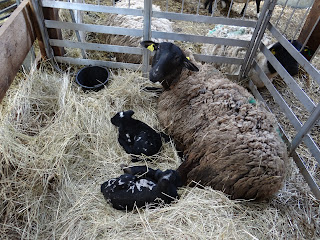A Year in Estonia - Spring
„Breeding sheep must be your passion if you do that“,
says Ants. He must know, he has been in the business for almost twenty years.
„The first years it cost us more than it brought in. And still a large portion
of our income is from the state supplements that we get as organic farmers.“
After years of learning and trial, this breeder eventually chose the Dorper breed. They have good mothering qualities, do not require much birthing aid and, for a breeder of meat sheep very importantly, they have mostly fur instead of wool. This means that they don’t need to be sheared, as they lose their winter coat by themselves – a lot less work.
So I learn that the breed has a huge impact on the
financial stability of the sheep breeder. A sheep sold for slaughtering will
bring in approximately 80€, as they are usually slaughtered when they reach
40kg and over the last couple of years, the price was at around 2€ per kg of
live weight. Selling the sheep to other breeders is more profitable: a six
month old breeding ewe can bring in around 150€, a breeding ram even 500€.
Of course, everybody’s goal in their business is to
make money. For the sheep breeder this means: He needs sheep who will grow
fast, stay healthy, and give birth to healthy lambs every year for as long as
possible. And all of that with hopefully as little assistance by the humans as
possible. Every spring, during the lambing time, these traits are being
assessed. If the ewe needs assistance at giving birth, she will leave the herd.
If the lambs are very weak or even have genetic diseases, the ewe is removed.
Only those who give birth by themselves to healthy, normal-sized lambs and
allows them to drink her milk will stay in the herd.
But what else could help the breeder? This is where I come
into play. Our research group has previously shown that certain serum proteins
can be measured in calves’ blood during the first weeks of their life, and from
those measurements, predictions about their weight gain can be made. Now we
want to see if the situation in sheep is the same, and what factors actually
influence those proteins. Is it the mother’s colostrum? Is it the intestinal
microbiome? Of course, I have to limit my projects, so these are the factors I
am mainly going to look at.
Five weeks, that is how long this year’s lambing
season on this farm lasts with its 300 breeding ewes. Every day, I am in the
stable and collect the information with which I will answer my research
questions.
First of all, of course, to measure weight gain, we
need to know the lambs’ birth weight. Of the 121 lambs that meet the criteria
to enter the study, the average birth weight is 3,37 kg.
I
milk some colostrum, that is: the first milk that is rich in immunoglobulins
(Igs) and thus helps develop the immune system of the lambs when they drink it.
On the following day, I draw a blood sample from the lamb. Later, in the
laboratory, I can measure the proteins I am interested in in both of these samples.
The proteins are mainly haptoglobin and serum-amyloid A, but I will also
measure IgG and the pro-inflammatory cytokines IL-6 and TNF-α. With the help of
statistical programs, we can see if the concentrations in the colostrum and the
lamb’s blood are associated, thus, if the lamb’s haptoglobin-levels depend on
the haptoglobin it receives from the mother.
I have months of pipetting ahead of me.
To study the intestinal microbiome, I take not only
fecal samples, but also swabs directly from the rectum, so that I get some
intestinal epithelial cells and can make sure there are no environmental
bacteria in my sample. With DNA analysis and microscopic examinations, we will
find out what is going on the lambs’ guts – and how it changes over time.
My hypothesis is this: All of the lambs get into
contact with the bacteria and the parasites in the stable and on the grassland.
Those that have a strong innate immune system, which I measure by those
proteins haptoglobin and serum-amyloid-A, have it easier to fight those
pathogens and later on grow better. And if the statistical analysis that I will
perform once the sheep are all grown-up confirms this hypothesis, then I can
tell Ants and his fellow sheep-breeders: If you want to know which of your
sheep will grow the best, measure their serum-amyloid A in the second week of life!





So wie Leidenschaft Schafzucht erfolgreich macht, führt Engagement zur guten Bachelorarbeit. Mit bachelorarbeit schreiben lassen an der Seite wird das Schreiben leichter und das Ergebnis überzeugender.
AntwortenLöschen